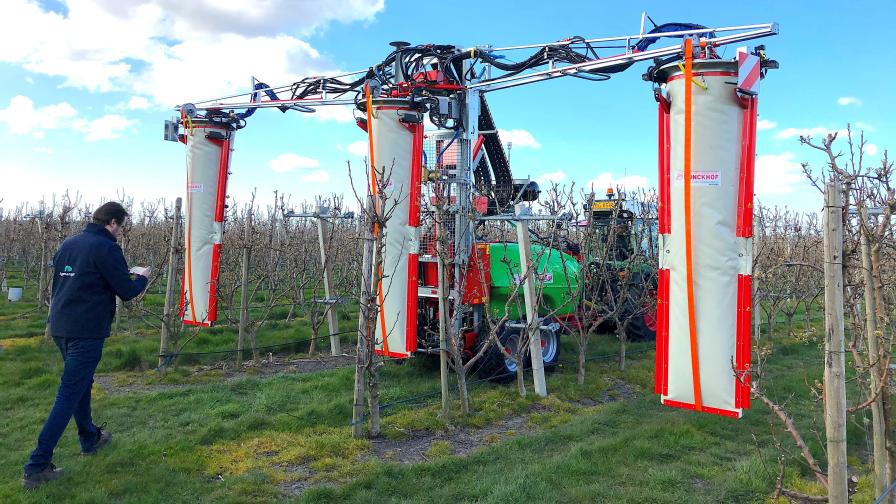Tackling New Technology Part of the Territory for Pome Fruit Growers Today
Three Michigan apple growers have spent their previous one or two growing seasons experimenting with various crop load management technologies still in development. Since then they have relayed their experiences to fellow growers, first at the Great Lakes Expo, and later at the annual meeting of the International Fruit Tree Association — both in Grand Rapids, MI.
While Michigan State University (MSU) Extension has spent those years identifying and ground truthing the respective technologies, much work has been done by the trio of growers, according to now former MSU Apple Production Specialist Anna Wallis.
“These are the people that are brave enough to take this risk and push these technologies through the pipeline, knowing they’re probably not going to work the first time around, and having a big learning curve,” says Wallis, now the Fruit IPM Coordinator with the Cornell New York State IPM Program.
Jamie Kober, Riveridge Land Co., Sparta, MI; Outfield (drone/fruit mapping technology)
While traditional yield estimates arrive from hand counts of a small number of trees, the Outfield’s drone technology allows growers to survey whole orchards, quickly creating datasets that are tested and strengthened every time they scan. Targeted management and thinning is achieved using Outfield’s fruit mapping technology, which improves the chance of optimizing early fruit set to ensure on-spec harvests.

Photo courtesy of Outfield
“The drone-based system is very easy to use. You outline a map on Google maps. Upload that flight plan. It really flies itself,” Kober says. “I put it off the tailgate of my pickup. I just hit go. It did its thing and came back 10 minutes later and landed on my tailgate. You upload the data, and it goes into the cloud.
“You could fly the drone as many times as you want. What I thought most interesting was the (successive) maps matched identically as far as variations. What they detected with the blossoms, that’s what ended up happening with the crop. What we took away from this is it was easy to use. It’s quick. It’s not driving up and down the rows. But there are definitely some questions about occlusions. There are a lot of different things that are going to maybe throw off what happens in the end.”
Dan Zemaitis, LTI Ag Research, Kent City, MI; Pometa/formerly Farm Vision Technologies (computer vision)
Computer vision, a form of artificial intelligence, allows growers to accurately identify and classify fruitlets, count clusters, and monitor growth rates while recording how many fruits there are, where, and how they are positioned.
“This was our second year working with this company, and I can say it has gained in accuracy from the year before,” Zemaitis says. “It is actually to a point that it’s very much trustworthy and a huge time-saver as far as getting fruit counts, knowing how much fruit you have on a tree, and having quicker turnaround times as far as knowing when to do thinning applications.
“The nice thing about this tool is, not only do you use it at thinning time, but you can actually take it into getting an idea of what you’ve got preharvest. I’m not 100% sure if I would say the model is perfected yet, but simply knowing you have what it reads out at the moment was very valuable to us.”
Elizabeth Pauls, Wittenbach Orchards, Belding, MI; Munckhof/Aurea Imaging (three-row sprayer/digital mapping technology)
Aurea Imaging creates blossom and vigor maps, using drone footage to assess the blossom density and the vigor of each individual tree. The maps are validated jointly by university researchers, Aurea Imaging, and the fruit grower. They are then automatically converted to digital task maps for Munckhof’s automatic VariMAS sprayer, which was chosen for the demo project because of its high drift-reduction capability and accuracy in combination with its low consumption of spraying agents and fuel.

Photo courtesy of Munckhof Fruit Tech Innovators
The sprayer is equipped with GPS technology that accurately recognizes fruit trees based on digital task maps. The single-nozzle activation feature, with a response time of 0.2 seconds, allows highly accurate selective activation at individual tree level. It executes the spraying strategy fully automatically for each zone. This guarantees each tree is sprayed based on the correct spraying strategy.
“We could ultimately set the threshold of bloom density we want to spray. It’s kind of a yes or no spray: Is the sprayer turning on or off on each individual tree?” Pauls says. “It’s a starting point to bring uniformity into a block with bloom thinner. On your on-year, you always have (trees) that are off. Could you bring those in together and then treat the block more uniformly throughout the entire year? I’m excited for that potential.”










